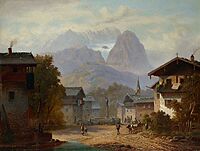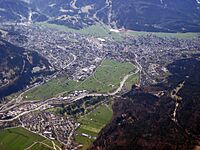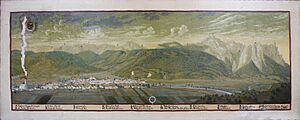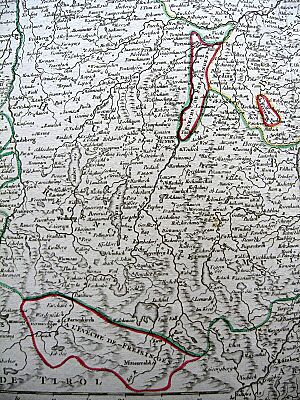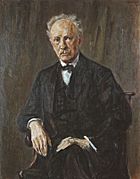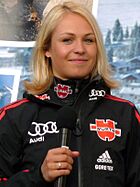Garmisch-Partenkirchen facts for kids
Quick facts for kids
Garmisch-Partenkirchen
|
||
|---|---|---|
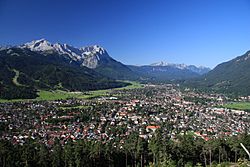
Garmisch-Partenkirchen in September 2009,
Alpspitze and Zugspitze in background left |
||
|
||
| Country | Germany | |
| State | Bavaria | |
| Admin. region | Oberbayern | |
| District | Garmisch-Partenkirchen | |
| Elevation | 708 m (2,323 ft) | |
| Population
(2022-12-31)
|
||
| • Total | 27,482 | |
| Time zone | CET/CEST (UTC+1/+2) | |
| Postal codes |
82467
|
|
| Dialling codes | 08821 | |
| Vehicle registration | GAP | |
| Website | www.gapa.de | |
Garmisch-Partenkirchen is a beautiful ski town in Bavaria, southern Germany. It's located in the Northern Limestone Alps, close to the border with Austria. This town is the main center of the Garmisch-Partenkirchen district. Germany's highest mountain, Zugspitze, which is about 2,962 meters (9,718 feet) tall, is very close by.
The town is famous because it hosted the 1936 Winter Olympics. This was the first time alpine skiing was included in the Olympics! Garmisch-Partenkirchen still hosts many different winter sports events today.
Contents
History of Garmisch-Partenkirchen
Garmisch and Partenkirchen were actually two separate towns for a very long time. Even today, they feel a bit different from each other.
Ancient Roots of Partenkirchen
Partenkirchen started as a Roman town called Partanum. It was an important stop on a trade route that went from Venice to Augsburg. We know about it from as early as the year 15 AD! The main street in Partenkirchen, Ludwigsstrasse, still follows the path of that old Roman road.
Garmisch's Beginnings
Garmisch was first mentioned much later, about 800 years after Partenkirchen. It was called Germaneskau, which means "German District." This name suggests that a Teutonic tribe settled in the western part of the valley a long time ago.
Under the Prince-Bishops
In the late 1200s, the valley became part of the County of Werdenfels. This area was then ruled by the prince-bishops of Freising. They ruled until 1803. A special representative, called a Pfleger, managed the area from Werdenfels Castle. This castle was on a rocky hill north of Garmisch.
Challenging Times
When Europeans discovered America around the 1500s, sea trade became very popular. This caused overland trade to decline, which meant hard times for the region. The valley floor was also swampy, making farming difficult. Wild animals like bears, wolves, and lynxes were a constant danger to farm animals. People also suffered from diseases, including serious outbreaks of the bubonic plague.
Sadly, during these tough times, some people were accused of being witches. From 1589 to 1596, 63 people, which was more than 10% of the population, lost their lives in trials.
Werdenfels Castle and New Churches
Werdenfels Castle, where these trials happened, became a place people feared. It was left empty in the 1600s and mostly taken down in the 1750s. The stones from the castle were used to build the beautiful Neue Kirche (New Church) on Marienplatz, which was finished in 1752. This new church replaced the older Gothic Alte Kirche (Old Church). Parts of the Old Church were even older than Christianity and might have been a pagan temple once. After being used for storage, it has since become a church again, and you can still see some of its old medieval paintings.
Becoming One Town
Garmisch and Partenkirchen stayed separate until 1935. That year, Adolf Hitler made the mayors combine the two towns. This happened just before the 1936 Winter Olympics. Today, people often just say "Garmisch" when talking about the united town, which can sometimes bother the people from Partenkirchen! Visitors might notice that Garmisch feels a bit more modern, while Partenkirchen, with its cobblestone streets and buildings covered in paintings, looks more historic. In the mornings and evenings, you might even see dairy cows being herded through the streets to and from the mountain meadows!
During World War II, Garmisch-Partenkirchen was an important hospital center for the German military.
Climate
Garmisch-Partenkirchen has a climate that is somewhat like an oceanic climate, but its winters are colder than many other parts of Bavaria. Because it's high up in the mountains, its winters are quite snowy and wet. It gets a lot of rain and snow throughout the year. In fact, in 2013, the areas around the town were known for having the most thunderstorm days in Europe!
| Climate data for Garmisch-Partenkirchen (1991–2020 normals, extremes 1936–present) | |||||||||||||
|---|---|---|---|---|---|---|---|---|---|---|---|---|---|
| Month | Jan | Feb | Mar | Apr | May | Jun | Jul | Aug | Sep | Oct | Nov | Dec | Year |
| Record high °C (°F) | 19.0 (66.2) |
21.4 (70.5) |
25.3 (77.5) |
29.2 (84.6) |
31.7 (89.1) |
35.1 (95.2) |
36.4 (97.5) |
35.7 (96.3) |
32.0 (89.6) |
27.8 (82.0) |
23.7 (74.7) |
18.6 (65.5) |
36.4 (97.5) |
| Mean daily maximum °C (°F) | 3.2 (37.8) |
5.7 (42.3) |
10.0 (50.0) |
14.5 (58.1) |
18.4 (65.1) |
21.5 (70.7) |
23.4 (74.1) |
23.1 (73.6) |
18.7 (65.7) |
14.5 (58.1) |
8.2 (46.8) |
3.3 (37.9) |
13.7 (56.7) |
| Daily mean °C (°F) | −2.1 (28.2) |
−0.5 (31.1) |
3.5 (38.3) |
7.8 (46.0) |
12.1 (53.8) |
15.5 (59.9) |
17.1 (62.8) |
16.6 (61.9) |
12.5 (54.5) |
8.2 (46.8) |
2.7 (36.9) |
−1.4 (29.5) |
7.7 (45.9) |
| Mean daily minimum °C (°F) | −5.8 (21.6) |
−5.0 (23.0) |
−1.7 (28.9) |
1.7 (35.1) |
5.9 (42.6) |
9.6 (49.3) |
11.2 (52.2) |
11.1 (52.0) |
7.5 (45.5) |
3.6 (38.5) |
−1.1 (30.0) |
−4.6 (23.7) |
2.8 (37.0) |
| Record low °C (°F) | −25.8 (−14.4) |
−29.3 (−20.7) |
−21.2 (−6.2) |
−12.6 (9.3) |
−4.6 (23.7) |
−0.2 (31.6) |
3.5 (38.3) |
1.8 (35.2) |
−2.3 (27.9) |
−8.2 (17.2) |
−17.3 (0.9) |
−24.4 (−11.9) |
−29.3 (−20.7) |
| Average precipitation mm (inches) | 77.3 (3.04) |
65.5 (2.58) |
90.3 (3.56) |
87.2 (3.43) |
143.4 (5.65) |
179.7 (7.07) |
172.6 (6.80) |
191.9 (7.56) |
115.4 (4.54) |
91.0 (3.58) |
80.8 (3.18) |
77.8 (3.06) |
1,379.3 (54.30) |
| Average precipitation days (≥ 1.0 mm) | 14.6 | 13.6 | 15.9 | 15.5 | 18.6 | 19.8 | 19.0 | 18.0 | 16.2 | 13.9 | 14.0 | 15.4 | 195.4 |
| Average snowy days (≥ 1.0 cm) | 27.4 | 23.6 | 14.9 | 2.5 | 0.2 | 0 | 0 | 0 | 0 | 0.8 | 8.9 | 21.1 | 99.4 |
| Average relative humidity (%) | 86.2 | 80.9 | 76.2 | 72.2 | 74.1 | 75.8 | 76.4 | 79.3 | 82.6 | 83.5 | 87.0 | 89.3 | 80.3 |
| Mean monthly sunshine hours | 74.6 | 106.1 | 148.6 | 168.8 | 172.1 | 176.2 | 201.1 | 199.5 | 163.7 | 135.3 | 80.2 | 55.7 | 1,665.9 |
| Source 1: World Meteorological Organization | |||||||||||||
| Source 2: DWD (extremes) | |||||||||||||
Transportation in Garmisch-Partenkirchen
The town is easy to reach by road. The B 2 road continues from the A 95 motorway, which ends about 16 kilometers (10 miles) north of the town.
Train Connections
Garmisch-Partenkirchen station is a busy train hub. It's on the line that connects to Munich Central Station and the Mittenwald Railway which goes to Innsbruck. Trains run every hour to Munich and Mittenwald, and every two hours to Innsbruck and Reutte. During certain seasons, special long-distance trains, including fast ICEs, connect the town to major German cities like Berlin and Hamburg.
The town is also the end point for the Außerfern Railway to Reutte in Tirol and the Bavarian Zugspitze Railway. This special railway, which has parts of a rack railway, takes you all the way up to the Zugspitze, Germany's highest mountain!
You can also find many easy and challenging hiking trails starting from the town, offering amazing views.
Sports and Activities
Garmisch-Partenkirchen is a very popular place for holidays, especially for skiing, snowboarding, and hiking. It has some of the best skiing areas in Germany, like Garmisch Classic and Zugspitze.
Olympic History
As mentioned, it was the host of the 1936 Winter Olympics. It was even chosen to host the 1940 Winter Olympics, but those games were canceled because of World War II.
Skiing Competitions
Many important Nordic and alpine World Cup ski races happen here, usually on the Kandahar Track. Every New Year's Day, there's a famous ski jumping contest in Garmisch-Partenkirchen, which is part of the Four Hills Tournament. The FIS Alpine World Ski Championships were also held here in 1978 and 2011.
Garmisch-Partenkirchen was part of Munich's bid to host the 2018 Winter Olympics, but the games were awarded to Pyeongchang.
Team Sports
In team sports, the professional ice hockey team SC Riessersee, which has won the German championship 10 times, plays at the Garmisch Olympia Stadium. The local association football (soccer) team is 1.FC Garmisch-Partenkirchen.
Exciting Events
Garmisch-Partenkirchen hosts many fun events throughout the year:
- January: New Year's Ski Jump and the "Hornschlittenrennen" (a traditional sled race).
- January / February: FIS Alpine Ski World Cup races.
- February: Historic bob-race on the Olympic track at Riessersee.
- April 30: "Georgimarkt" in Partenkirchen.
- May–October: "Musik im Park" (Music in the Park).
- June: Zugspitz Ultratrail, a trail running event around the Zugspitze, and the Richard-Strauss-Festival.
- July: The first weekend usually features BMW Motorbike Days, and on July 15th, there's "White Night."
- July / August: "Festwoche" Festival in Garmisch and Partenkirchen.
- August: "Alpentestival."
- August/September: Straßen.Kunst.Festival (Street Art Festival).
- November: "Martinimarkt" in Garmisch.
Important Public Institutions
Garmisch-Partenkirchen is home to the George C. Marshall European Center for Security Studies. This is a learning and conference center funded by many countries, mainly the U.S.. It helps governments from around the world, especially from former Soviet Union and Eastern European countries, learn about security.
Close by is the American Armed Forces Recreation Centers (Edelweiss Lodge and Resort). This resort is for U.S. and NATO military members and their families. Some U.S. troops and civilians live in the town to support these centers.
The town also has the German Centre for Pediatric and Adolescent Rheumatology. This is the largest special center in Europe for treating children and teenagers with rheumatic diseases. It has been active since 1952.
Twin Towns – Sister Cities
Garmisch-Partenkirchen has special friendships with other towns around the world, called twin towns:
 Aspen, United States
Aspen, United States Chamonix-Mont-Blanc, France
Chamonix-Mont-Blanc, France Lahti, Finland
Lahti, Finland
Famous People from Garmisch-Partenkirchen
Many notable people have lived in or come from Garmisch-Partenkirchen:
- Hermann Levi (1839–1900), a Jewish orchestral conductor.
- Richard Strauss (1864–1949), a leading German composer.
- Ludwig Thoma (1867–1921), an author known for describing Bavarian life.
- Sir Karl Popper (1902–1994), an important Austrian-British philosopher.
- Michael Ende (1929–1995), a famous writer of fantasy and children's books, known for The Neverending Story.
- Wolfgang Seiler (born 1940), a biogeochemist and climatologist.
- Robert Rosner (born 1947), an astrophysicist.
- Hans Peter Blochwitz (born 1949), a lyric tenor who sings in Mozart operas.
- Marina Anna Eich (born 1976), a film actress and producer.
Famous Sports Figures
- Hanns Kilian (1905–1981), a bobsledder.
- Käthe Grasegger (1917–2001), an alpine skier.
- Christian Neureuther (born 1949), an alpine ski racer.
- Rosi Mittermaier (1950–2023), a famous alpine ski racer and double Olympic gold medalist.
- Hans-Joachim Stuck (born 1951), a racing car driver.
- Armin Bittner (born 1964), an alpine skier.
- Maria Höfl-Riesch (born 1984), an alpine skier.
- Felix Neureuther (born 1984), an alpine skier.
- Magdalena Neuner (born 1987), a six-time biathlon world champion and Olympic champion.
- Laura Dahlmeier (born 1993), a biathlete and double Olympic gold medalist.
Points of Interest
There are many amazing places to see around Garmisch-Partenkirchen:
Natural Wonders
South of Partenkirchen, you can visit the Partnach Gorge. Here, the Partnach river rushes powerfully through a narrow, 1-kilometer-long (0.6-mile-long) gap between tall limestone cliffs. The Zugspitze, Germany's highest mountain, is south of Garmisch near the village of Grainau. This mountain actually sits on the border with Austria. Another impressive mountain overlooking Garmisch-Partenkirchen is Germany's fourth-highest, the Leutasch Dreitorspitze, which means "Three-Gate Peak" because of its three summits.
Royal Retreats
The King's House on Schachen is a small castle built for Ludwig II of Bavaria. It's located in the mountains south of Garmisch-Partenkirchen. Around the castle, you'll find the Alpengarten auf dem Schachen, which is an alpine botanical garden with beautiful mountain plants.
See also
In Spanish: Garmisch-Partenkirchen para niños



